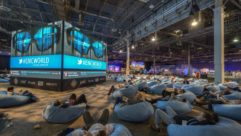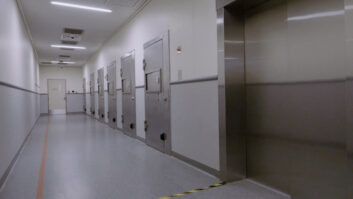Planning the bed
Mar 1, 1996 12:00 PM,
By Ron Barker
Planning for the Rose Garden, initially called the Oregon Arena, began in 1991 when architect Ellerbe Becker signed Wrightson, Johnson, Haddon & Williams (WJHW) as consultants for room acoustics and HVAC noise control, along with providing technical designs for the sound system and television RF distribution system.
One of the early topics of discussion involved the acoustics of the seating bowl and how live or dead the room should be. The Trailblazers’ previous arena is a much smaller building with a relatively dead acoustical quality. Even with the reduced seating capacity, the small interior volume of the old building permitted the Blazer fans to fill the room with noise. But there was a concern that when the team moved to the new facility, the crowd noise would be comparatively weak because of the much larger interior volume. The normal way to overcome such a concern would be to make the interior of the seating bowl very live to support the crowd noise; however, such an environment would not be acceptable in the touring concert market, which was also intended to be a major user of the building.
Several different acoustical approaches were evaluated, but each represented a compromise to the eventual goal of good acoustics for a wide variety of events. Finally, the subject of adjustable or variable acoustic treatment was explored. Because of the additional cost associated with such a solution, an auralization study was conducted to better demonstrate the benefits of the adjustable acoustics. Using computer models of the arena and sophisticated digital-processing software, a series of acoustical scenarios were prepared to show how different acoustical materials and treatments would affect the overall performance in the seating bowl. After reviewing the results of the auralization presentation, the owner agreed to proceed with the more sophisticated variable acoustic treatment in the facility.
Various methods of changing the room acoustics were studied, but the final solution worked out with the rigging consultant Langenstein Associates involved a series of rotating panels suspended from steel battens. The battens formed eight parallel rows, one for each side, down the long axis of the room. The center area over the court was left open for rigging of concerts and other events such as the circus. Each row of battens could be adjusted vertically, and each panel consisted of a curved, reflective side and an absorptive side. With a total of 160 adjustable panels, each 10 ft2 (0.9 m2), the system provided the ability to control up to 16,000 ft2 ( 1,486 m2) of absorption or diffusion within the room.
For sporting events where the crowd noise is wanted, the panels are positioned with their hard side down, and the battens are placed as low as possible without blocking sightlines to the scoreboard from any seat. During a concert when the scoreboard is not used, the battens can be lowered even further with the absorptive side facing the audience. This not only reduces the perceived reverberation within the room but can also provide the effect of an artificial ceiling to decrease the apparent size of the room. Because the panels can be rotated in small groups, it is also possible to mix the hard and soft panels to provide a blend of absorption and reflectivity. Because the positioning of the battens and the orientation of the panels are all motorized, the arena operators can very quickly and easily change the character of the room – even during an event if necessary. Although several other conventional fixed acoustical treatments were also used in the arena, the adjustable panels remain the most unique and visible element.
The development of the sound system proceeded along with the evolution of the acoustical solution. Loudspeaker systems in arenas usually fall into one of three general styles: central cluster, satellite cluster and distributed. The distributed-type system, which is the least common because of its higher cost and special building requirements, consists of many individual loudspeaker cabinets located over small areas of the audience.
By limiting the amount of coverage and the distance to each listener, these systems achieve good performance without projecting large amounts of wasted acoustic energy onto undesirable areas, such as vertical walls or glass. Arco Arena in Sacramento has a distributed system. Satellite systems consist of several clusters – usually located over the hockey dasher board in a circular or oval pattern – that place the loudspeakers nearer than with a central cluster but not as close as a distributed system. Satellite cluster systems work well for buildings with a strong hockey presence because the placement of the loudspeakers permit the sound to reach the seats directly behind the dasher board glass. The United Center in Chicago and Fleet Center in Boston have this type of system.
Because the primary tenant is an NBA basketball franchise, the central cluster approach was used. But because the scoreboard occupied the actual middle of the room, the cluster was divided into four segments and located just outside the path of the scoreboard. The acoustical panels were suspended as low as possible, so it was necessary for the loudspeaker clusters to be movable – down for normal sporting events and pulled up high for concerts or events that brought their own system. A cable-drum type of winch was used for each of the four clusters, with the controls in the catwalk where the movement could be easily monitored.
Although the segmented or exploded cluster shares many of the benefits of a true central cluster, the seating areas that fall within the gap of the clusters must be carefully adjusted to prevent arrival problems where the adjacent clusters overlap. The issue was resolved by separately delaying each cluster to ensure proper synchronization. Other arenas using this same style of system include the Target Center in Minneapolis and The Pond in Anaheim.
A delay ring of loudspeakers was used to cover the last five or six rows of the upper-deck seating. These loudspeakers allowed the main cluster components to be aimed downward a bit more, keeping excess sound energy from striking the large vertical wall behind the last row of seats and generating discrete reflections back into the room.
The final result of the loudspeaker system and the acoustics within the room have been well-received by the owner and the fans. Although it will take some time to arrive at the final sports configuration for the panel system, once the preferred settings have been determined, they can be changed for a special event and restored within a matter of minutes. Such a solution is also adaptable to other facilities that have a strong desire to optimize the acoustical nature of the room with the event being presented.










